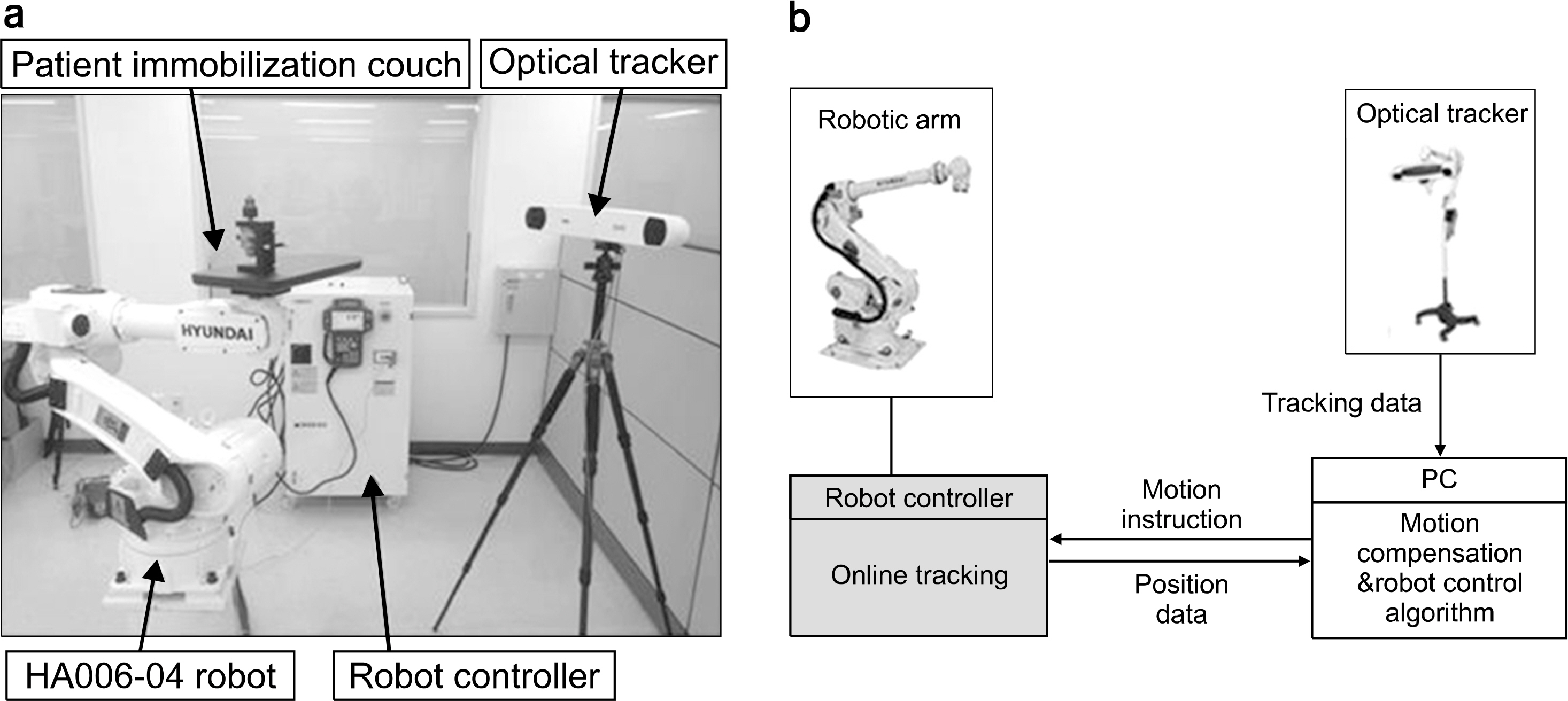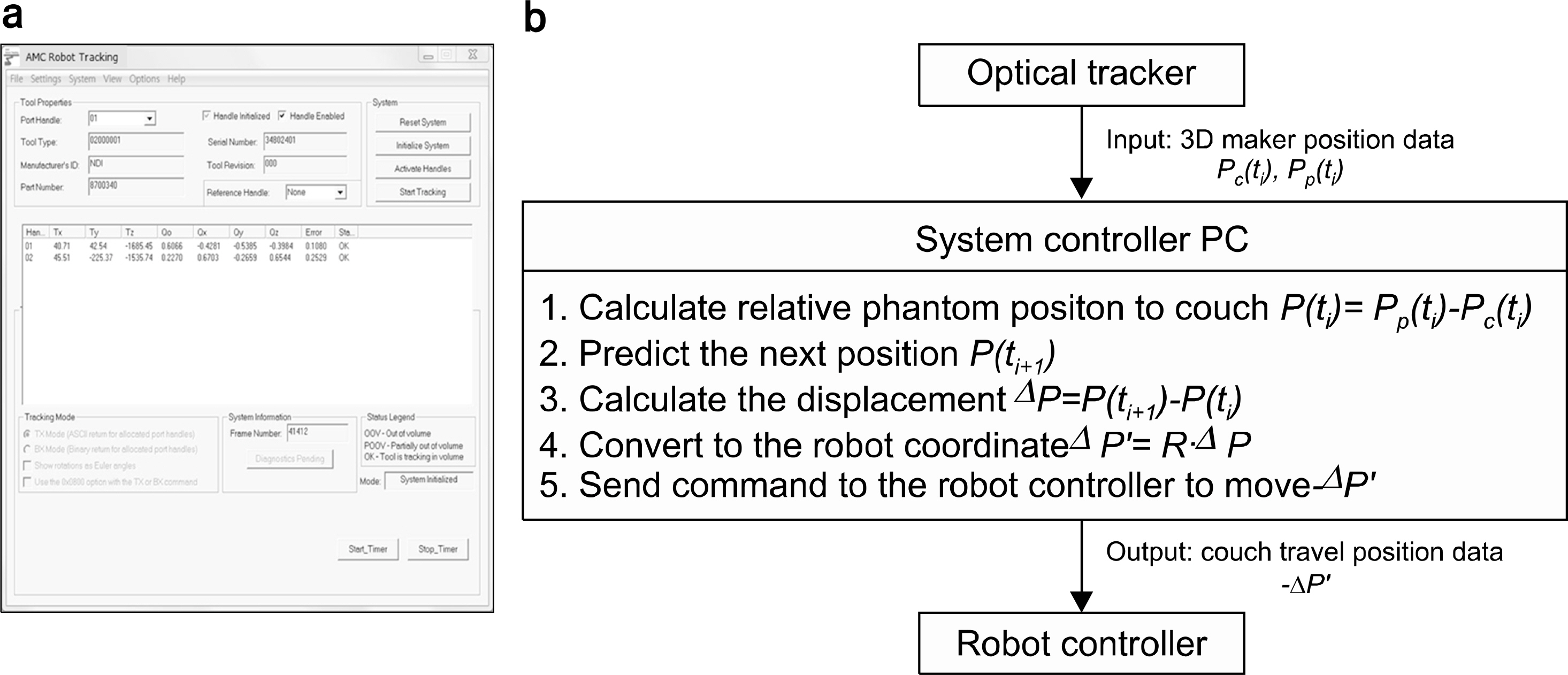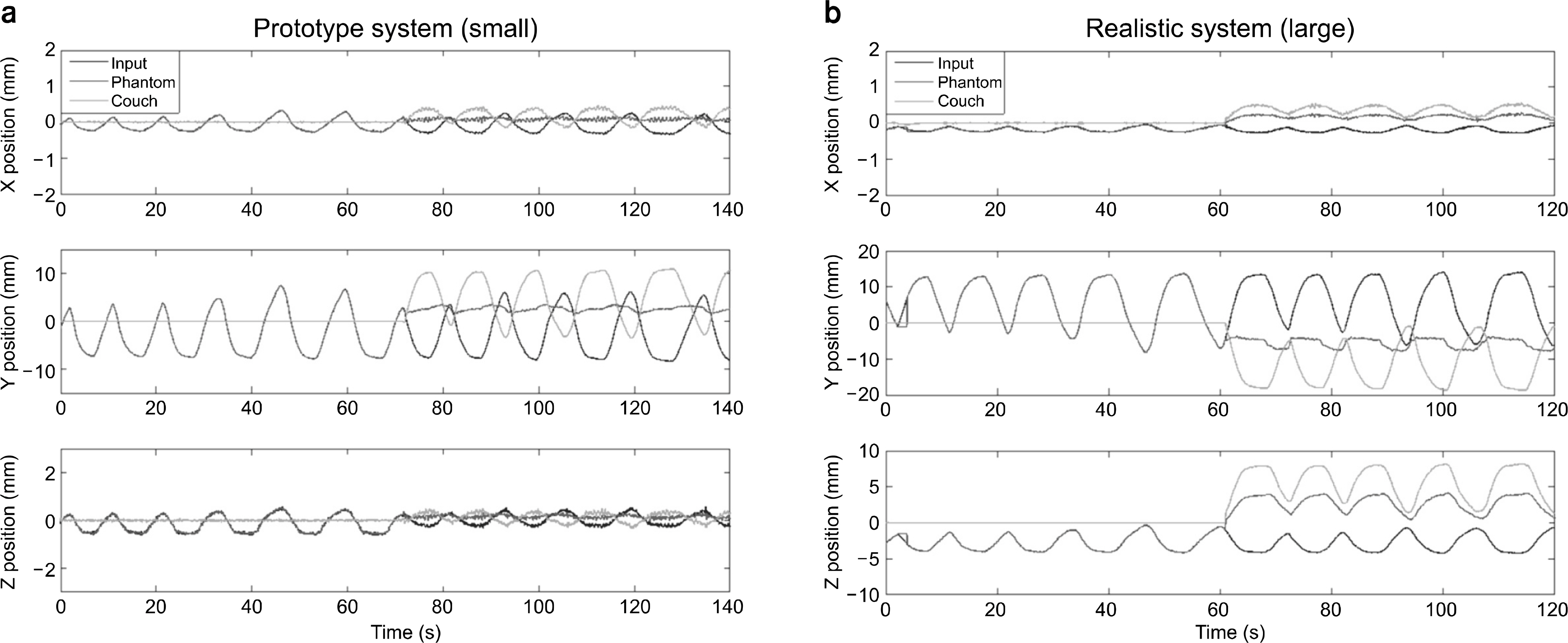Prog Med Phys.
2016 Sep;27(3):117-124. 10.14316/pmp.2016.27.3.117.
Feasibility Study of Robotics-based Patient Immobilization Device for Real-time Motion Compensation
- Affiliations
-
- 1Department of Nuclear and Quantum Engineering, Korea Advanced Institute of Science and Technology, Daejeon, Korea.
- 2Department of Radiation Oncology, Asan Medical Center, University of Ulsan College of Medicine, Seoul, Korea. cho.byungchul@gmail.com bcho@amc.seoul.kr
- KMID: 2376541
- DOI: http://doi.org/10.14316/pmp.2016.27.3.117
Abstract
- Intrafractional motion of patients, such as respiratory motion during radiation treatment, is an important issue in image-guided radiotherapy. The accuracy of the radiation treatment decreases as the motion range increases. We developed a control system for a robotic patient immobilization system that enables to reduce the range of tumor motion by compensating the tumor motion. Fusion technology, combining robotics and mechatronics, was developed and applied in this study. First, a small-sized prototype was established for use with an industrial miniature robot. The patient immobilization system consisted of an optical tracking system, a robotic couch, a robot controller, and a control program for managing the system components. A multi speed and position control mechanism with three degrees of freedom was designed. The parameters for operating the control system, such as the coordinate transformation parameters and calibration parameters, were measured and evaluated for a prototype device. After developing the control system using the prototype device, a feasibility test on a full-scale patient immobilization system was performed, using a large industrial robot and couch. The performances of both the prototype device and the realistic device were evaluated using a respiratory motion phantom, for several patterns of respiratory motion. For all patterns of motion, the root mean squared error of the corresponding detected motion trajectories were reduced by more than 40%. The proposed system improves the accuracy of the radiation dose delivered to the target and reduces the unwanted irradiation of normal tissue.
Keyword
MeSH Terms
Figure
Cited by 2 articles
-
Analysis of Motion-dependent Clinical Outcome of Tumor Tracking Stereotactic Body Radiotherapy for Prostate Cancer
Hoon Sik Choi, Ki Mun Kang, Bae Kwon Jeong, Jin Ho Song, Yun Hee Lee, In Bong Ha, Sung Chul Kam, Jeong Seok Hwa, Jae Seog Hyun, Jungmo Do, Dong Hyeok Jeong, Hojin Jeong
J Korean Med Sci. 2018;33(14):. doi: 10.3346/jkms.2018.33.e107.Simulation and Experimental Studies of Real-Time Motion Compensation Using an Articulated Robotic Manipulator System
Minsik Lee, Min-Seok Cho, Hoyeon Lee, Hyekyun Chung, Byungchul Cho
Prog Med Phys. 2017;28(4):171-180. doi: 10.14316/pmp.2017.28.4.171.
Reference
-
1.Timmerman RD. Surgery versus stereotactic body radiation therapy for early-stage lung cancer: Who's down for the count? J Clin Oncol. 28(6):907–909. 2010.
Article2.Keall PJ., Mageras GS., Balter JM, et al. The management of respiratory motion in radiation oncology report of AAPM Task Group 76. Med Phys. 33(10):3874–3900. 2006.3.Ohara K., Okumura T., Akisada M, et al. Irradiation synchronized with respiration gate. Int J Radiat Oncol Biol Phys. 17(4):853–857. 1989.
Article4.Kubo HD., Hill BC. Respiration gated radiotherapy treatment: a technical study. Phys Med Biol. 41(1):83–91. 1996.
Article5.Ford EC., Mageras GS., Yorke E., Rosenzweig KE., Wagman R., Ling CC. Evaluation of respiratory movement during gated radiotherapy using film and electronic portal imaging. Int J Radiat Oncol Biol Phys. 52(2):522–531. 2002.
Article6.Vedam SS., Keall PJ., Kini VR., Mohan R. Determining parameters for respiration-gated radiotherapy. Med Phys. 28(10):2139–2146. 2001.
Article7.Schweikard A., Shiomi H., Adler J. Respiration tracking in radiosurgery. Med Phys. 31:2738–2741. 2004.
Article8.Murphy MJ. Tracking moving organs in real time. Semin Radiat Oncol. 14(1):91–100. 2004.
Article9.Keall PJ., Kini VR., Vedam SS., Mohan R. Motion adaptive X-ray therapy: a feasibility study. Phys Med Biol. 46(1):1–10. 2001.
Article10.Cho B., Poulsen PR., Sawant A., Ruan D., Keall PJ. Real-time target position estimation using stereoscopic kilovoltage/megavoltage imaging and external respiratory monitoring for dynamic multileaf collimator tracking. Int J Radiat Oncol Biol Phys. 79(1):269–278. 2011.
Article11.Fledelius W., Keall PJ., Cho B, et al. Tracking latency in image-based dynamic MLC tracking with direct image access. Acta Oncol. 50(6):952–959. 2011.
Article12.Poulsen PR., Cho B., Sawant A., Keall PJ, et al. Implementation of a new method for dynamic multileaf collimator tracking of prostate motion in arc radiotherapy using a single kV imager. Int J Radiat Oncol Biol Phys. 76(3):914–923. 2010.
Article13.Depuydt T., Poels K., Verellen D., Engels B, et al. Treating patients with real-time tumor tracking using the Vero gimbaled linac system: implementation and first review. Radiother Oncol. 112(3):343–51. 2014.
Article14.Lee S., Chang KH., Shim JB., Cao Y, et al. Evaluation of mechanical accuracy for couch-based tracking system (CBTS). J Appl Clin Med Phys. 13(6):157–169. 2012.
Article15.D'Souza WD., Naqvi SA., Yu CX. Real-time intra-fraction- motion tracking using the treatment couch: a feasibility study. Phys Med Biol. 50(17):4021–33. 2005.16.Olch AJ., Gerig L., Li H., Mihaylov I., Morgan A. Dosimetric effects caused by couch tops and immobilization devices: report of AAPM Task Group 176. Med Phys. 41(6):061501–1. -30. 2014.
Article17.Gevaert T., Verellen D., Engels B, et al. Clinical evaluation of a robotic 6-degree of freedom treatment couch for frameless radiosurgery. Int J Radiat Oncol Biol Phys. 83(1):467–474. 2012.
Article18.Bertholet J., Worm ES., Fledelius W., Høyer M., Poulsen PR. Time-resolved intrafraction target translations and rotations during stereotactic liver radiation therapy: implications for marker-based localization accuracy. Int J Radiat Oncol Biol Phys. 95(2):802–809. 2016.
Article
- Full Text Links
- Actions
-
Cited
- CITED
-
- Close
- Share
- Similar articles
-
- The Development of Real Time Automatic Patient Position Correction System during the Radiation Therapy Based on CCD: A Feasibility Study
- Evaluation of a Mobile Wound Care Device for Assessment of Wounds: A Time Motion Study
- Simulation and Experimental Studies of Real-Time Motion Compensation Using an Articulated Robotic Manipulator System
- Deep Learning in MR Motion Correction:a Brief Review and a New Motion Simulation Tool (view2Dmotion)
- Real-time Body Surface Motion Tracking using the Couch Based Computer-controlled Motion Phantom (CBMP) and Ultrasonic Sensor: A Feasibility Study





